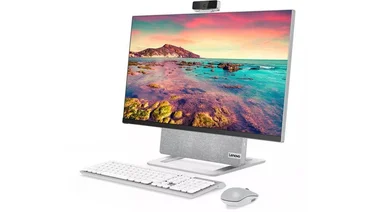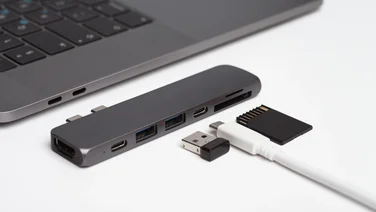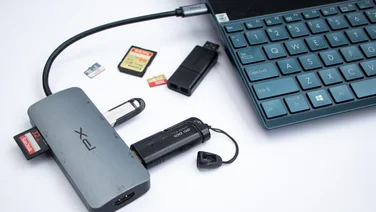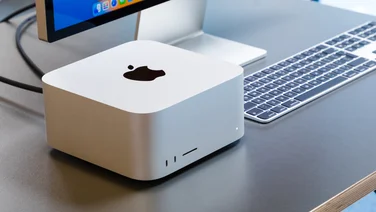To help us provide you with free impartial advice, we may earn a commission if you buy through links on our site. Learn more







- Compact form factor
- Nippy performance
- Lots of ports
- Customisable internals
- Expensive
- Takes time to set up
- Bigger than previous NUCs
One look at the glowing blue skull adornment on the top of the NUC8i7HVK and you can tell this is a radical departure from Intel’s previous NUC (Next Unit of Computing) Kits. These barebones PCs have always been grey, boxy little things but the new NUC – codenamed Hades Canyon – is bigger, bolder and more tightly focused on performance than ever.
Indeed, it’s the first NUC Kit to make a serious attempt at becoming a gaming machine and does so with the help of a surprising assistant: Intel’s arch-rival, AMD. Next to Intel’s own quad-core, eight-thread Core i7-8809G, the NUC8i7HVK is equipped with a Radeon RX Vega M GH graphics chip, a slightly faster cousin of the RX Vega M GL chip found in the top-spec HP Spectre x360 laptop.
Intel NUC Kit NUC8i7HVK review: What you need to know
Of course, this is a barebones PC, so there’s a spot of DIY that needs handling before you can set unleash the NUC8i7HVK’s full potential. The CPU and GPU are already installed, thankfully, but you must provide your own RAM, M.2 SSD and operating system (for example, Windows 10) and install them yourself.







After that, you’re ready to go. The NUC8i7HVK is hardly going to bother a high-end desktop for speed or features, but by mini-PC standards, it’s bordering on luxury: connectivity is excellent, the Core i7-8809G is a huge step up from the processors in Intel’s budget NUC Kits, and the RX Vega M GH can handle 1080p games far better than any integrated graphics – and can even have a fair crack at running titles at 1440p.
To be clear, this is neither integrated graphics nor a discrete graphics card. The CPU and GPU are distinct chunks of silicon included in a multi-chip module, so while they’re tightly interconnected, AMD’s graphics chip has its very own 4GB of HBM2 VRAM. That means, unlike integrated graphics, it’s not jostling with the CPU for a shared memory pool, thus improving performance.
READ NEXT: The best mini-PCs you can buy
Intel NUC Kit NUC8i7HVK review: Price and competition
HBM2 rarely comes cheap, however, and anyone used to Intel’s sub-£150 NUCs might baulk at the NUC8i7HVK costing £853. Remember, also, that this excludes the RAM, storage and operating system.
For the purposes of testing, we installed a single 8GB stick of DDR4 RAM, a 256GB NVMe SSD and Windows 10 Home, which would add around an extra £235. You could perhaps get this down below £200 with a smaller-capacity, SATA-based SSD, but still, that’s over £1,000 total for a mini-PC – no small ask, Vega graphics or otherwise.
There are cheaper variants of this NUC that use the same chassis. For £705, you could opt for a slightly downgraded Core i7-8705G processor, which has the same GPU as the HP Spectre x360, and there’s also the £486 “Skull Canyon” model with a Core i7-6770HQ and integrated Iris Pro Graphics 580.
In the NUC Kit’s favour, there aren’t many mini-PCs with a comparably shared CPU/GPU performance focus and certainly none that are as small as this. The closest might be Zotac’s barebones Magnus ER51060 and Magnus ER51070 systems, which are similar width-wise but a lot deeper and taller.







These employ AMD Ryzen 5 1400 CPUs and, respectively, GeForce GTX 1060 and GTX 1070 graphics cards, so are better for gaming even if they’re slower for CPU-heavy tasks. That said, they also cost £755 and £1,015, without factoring in additional memory, storage and OS costs – so neither is particularly cheap.
Intel NUC Kit NUC8i7HVK review: Design
It’s worth reassuring NUC purists that, despite the redesign and emphasis on graphics, the new NUC Kit is still a very sensible, very compact mini-PC. That illuminated skull can be switched off in the BIOS if you find it distasteful and the chassis measures a scant 39mm tall, 221mm wide and 142mm deep, leaving it small enough to be VESA-mounted to the back of a monitor, just like the smaller NUCs. It’s a fraction of the size of Zotac’s Magnus PCs, but it also squeezes in a few more connectivity ports.
Most are, naturally, located on the rear, and include four USB 3 ports, two Thunderbolt 3-enabled USB Type-C ports, dual Gigabit Ethernet ports, one HDMI output and two mini-DisplayPorts sockets. That alone would be a respectable, varied selection for such a small PC, but there’s more. A mini optical TOSLINK output gives the NUC Kit extra flexibility in hooking up audio devices, while on the front, there’s even more room for connecting peripherals and removable storage with a USB 3.0 port, USB 3.1 port, USB Type-C port and an SD card reader.







Intel has also put an extra HDMI output on the front of the system, which seems like an odd location, but it’s a great idea for plugging in a VR headset – far more so than having to reach around to the rear I/O panel every time you want to play a VR game.
Cracking open the chassis to install that crucial extra hardware isn’t as easy as on the Magnus PCs, which use a mere four thumbscrews and a single covering panel. On the NUC8i7HVK, six tiny screws must be removed with the included Allen key, freeing the top panel. Then there’s another metallic panel, featuring the lighting gubbins for the skull, which is removed by way of an even smaller Phillips-head screw. Only once this has been removed can you access the component slots below. It’s not a difficult process, just one that’s a bit more time-consuming than I’d like it to be.
Still, component capacity is definitely up to snuff. You get two SO-DIMM memory slots, just like you do with the fatter Zotac Magnus PCs, as well as a pair of empty M.2 slots: one that will take an 80mm drive, the other a 42mm drive. That’s handy in case you run out of space on your SSD, as you can simply add another instead of having to swap it out for a larger model. The main chamber also includes a preinstalled 802.11ac Wi-Fi card, adding a useful alternative to the wired Ethernet ports.
Intel NUC Kit NUC8i7HVK review: Performance
A couple of paragraphs ago, you may have thought that the notion of VR games being playable on something no larger than the average hardback book to be fanciful at best. The RX Vega M GH processor, however, surprises with its potency. The NUC Kit scored 4.3 in Valve’s SteamVR Performance Test, which sounds low considering it’s out of a possible 11, but Valve’s benchmark still classifies this score as “Capable” and should mean you can run AAA VR titles at 90fps or more on mostly medium settings.







The NUC Kit also handled Dirt: Showdown rather well, ending up with an average frame rate of 92fps at 1,920 x 1,080, 70fps at 2,560 x 1,440 and 39fps at 3,840 x 2,160, all with Ultra settings and 4x anti-aliasing enabled. Intel’s integrated graphics tend to, at best, only get smooth frame rates on low settings and/or sub-Full HD resolutions, so teaming up with AMD appears to have been a worthwhile endeavour.
Metro: Last Light Redux proved much tougher, though, with the NUC Kit failing to breach the 30fps mark at Very High settings at 1,920 x 1,080 – it fell just short, averaging 28fps. Meanwhile, 2,560 x 1,440 and 3,840 x 2,160 were, inevitably, too much, producing averages of 18fps and 7fps.
It’s possible to get 1440p up to a decent 34fps by disabling SSAA, which at this resolution won’t make much of a difference anyway but any excitement about the NUC8i7HVK having near-desktop grade gaming power should be tempered by the fact that it’s still outpaced by those mini-PCs that squeeze in a fully fledged graphics card. For comparison, the Magnus ER51060 achieved an average 133fps in Dirt at 1080p, and 44fps in Metro at 1080p. If your principal interest in a petite PC is for playing games, Zotac’s system is undoubtedly a better choice.
In fact, it’s general CPU performance where the NUC8i7HVK truly shines. In our 4K benchmarks it scored 132 in the image conversion test, 135 in the video test, 138 in the multitasking test and 136 overall, dealing a big counterpunch to the ER51060 as well as the ER51070. Overall, these only scored 85 and 108 respectively. The NUC Kit’s Geekbench 4 scores aren’t half bad either: 4,548 in the single-core test and 13,020 in the multicore test, only narrowly behind those of the 2018 Apple Mac mini, although, notably, the mini gained an inferior 129 overall score in our in-house benchmarks.
Amidst all the excitement about AMD’s involvement on the graphical side, it might be easy to overlook the Core i7-8809G itself. With eight cores and the ability to Turbo Boost from 3.1GHz to 4.2GHz, it’s demonstrably powerful and is even unlocked for overclocking in the BIOS, along with the GPU and RAM. This requires particular caution, though, as at stock speeds I recorded core temperatures already hitting 87°C.
READ NEXT: The best powerful and expandable PCs you can buy
Intel NUC Kit NUC8i7HVK review: Verdict
Even if the NUC8i7HVK isn’t some kind of miraculous desktop-killer, it is and will remain an impressive bit of engineering. It’s quite the feat for a system this small to cope not only with things such as photo and intense video editing and rendering but also good-quality gaming.
Hopefully this doesn’t become the sole direction of NUCs, as not everybody needs a combined work and gaming box and the appeal of cheap, palm-sized PCs doesn’t disappear just because there’s a bigger, beefier version on the market – especially since, to actually get the Vega graphics, you need to spend so much more. Still, if its Intel’s intent to spin-off a whole new separate series of gaming NUCs, the NUC8i7HVK is an encouraging start.
Intel NUC Kit NUC8i7HVK review: Key specifications
- Processor: Quad-core 3.1GHz Intel Core i7-8809G
- Processor socket: BGA (soldered)
- RAM: None included (tested with 8GB)
- Memory type: DDR4
- Maximum memory: 32GB
- Motherboard: Proprietary
- Motherboard chipset: Intel HM175
- Front USB ports: 1 x USB 3, 1 x USB 3.1, 1 x USB Type-C
- Rear USB ports: 4 x USB 3, 2 x USB Type-C
- Networking: 2 x Gigabit Ethernet, 802.11ac Wi-Fi
- Case type: SFF
- Case dimensions (HxWxD): 39 x 221 x 142mm
- Warranty: 3yr RTB







